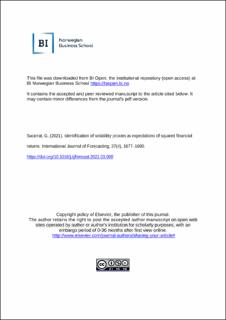Identification of volatility proxies as expectations of squared financial returns
Journal article, Peer reviewed
Accepted version
Permanent lenke
https://hdl.handle.net/11250/3091947Utgivelsesdato
2021Metadata
Vis full innførselSamlinger
Sammendrag
Volatility proxies like realised volatility (RV) are extensively used to assess the forecasts of squared financial returns produced by volatility models. But are volatility proxies identified as expectations of the squared return? If not, then the results of these comparisons can be misleading, even if the proxy is unbiased. Here, a tripartite distinction is introduced between strong, semi-strong, and weak identification of a volatility proxy as an expectation of the squared return. The definition implies that semi-strong and weak identification can be studied and corrected for via a multiplicative transformation. Well-known tests can be used to check for identification and bias, and Monte Carlo simulations show that they are well sized and powerful—even in fairly small samples. As an illustration, 12 volatility proxies used in three seminal studies are revisited. Half of the proxies do not satisfy either semi-strong or weak identification, but their corrected transformations do. It is then shown how correcting for identification can change the rankings of volatility forecasts.

